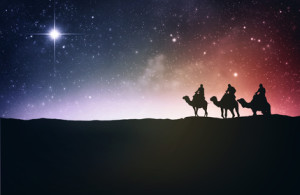 As a boy, I attended many a quaint Christmas nativity scene with baby Jesus in a manger surrounded by heralding angels, donkeys, Mary and Joseph, and bright lights illuminating the magical moment commemorating the birth of a boy who would grow to be the Christ. It was always in the countryside, usually on a clear, cold winter night. I can still taste the tart cider in the cup that warmed my hands as I wondered at what the entire scene meant. Of course I was taught the traditional story, but I always intuitively knew there was more to this magical moment than what my grandparents and religious leaders knew to share with me. For example, who were the three wise men that traveled from the East to pay homage? And what about their gifts of gold, frankincense, and myrrh? What did they really symbolize?
As a boy, I attended many a quaint Christmas nativity scene with baby Jesus in a manger surrounded by heralding angels, donkeys, Mary and Joseph, and bright lights illuminating the magical moment commemorating the birth of a boy who would grow to be the Christ. It was always in the countryside, usually on a clear, cold winter night. I can still taste the tart cider in the cup that warmed my hands as I wondered at what the entire scene meant. Of course I was taught the traditional story, but I always intuitively knew there was more to this magical moment than what my grandparents and religious leaders knew to share with me. For example, who were the three wise men that traveled from the East to pay homage? And what about their gifts of gold, frankincense, and myrrh? What did they really symbolize?
I remember hearing this story during Children’s Church on a Wednesday night one year, and I kept wanting to ask questions about these wise men. Our teacher knew enough to tell me that the Bible didn’t really mention three, and that it was only tradition that declared it to be so. Our teacher also told me that Jesus’ star they followed might have been a comet that came through our solar system for the special event, but she wasn’t sure. These answers only made my questions larger. I decided that one day I would get to the bottom of them.
The answers came for all these questions as I dug beyond the literal stories of the Bible years ago. Today I want to address the three wise men and their gifts, Jesus’ star, and the reason they came to pay homage to the baby Jesus in the first place.
Anny did a great job in her last article, The Generation of the Christ. She taught us that the lineage of Christ was more than just Biblical people who served God and were part of the overall plan to bring about the boy known as Jesus; she showed us that Jesus’ family tree was also about us, too. We all symbolically are meant to live as an Abraham, an Isaac, and a Jacob. The qualities of our soul are meant to eventually express a Rachel, a Leah, a Boaz, and a King David. All these soul qualities are eventually meant to come to express Jesus and then a Christ within us. In a sense, we are all meant to be the LIVING WORD, just as Jesus was meant to be. We are the body of Christ, the true church, beyond the four literal walls of a building.
The three wise men and the gifts they brought the baby Jesus also symbolize the soul qualities we must come to express in order to build a temple/church body that is worthy for the return of Christ as something within each of us individually. Let’s break the story down by starting with scripture.
“Now when Jesus was born in Bethlehem of Judea in the days of Herod the king, behold, there came wise men from the east to Jerusalem, Saying, where is he that is born king of the Jews? For we have seen his star in the east and have come to worship him” (Matt. 2:1-3).
Historically, the wise men (magi), from the Greek word magos, have their roots in the ancient Persian religion of Zoroastrianism. The priestly caste of Zoroastrianism were astrologers, which was considered the highest science of the day. They interpreted the signs of the heavens, and this is why they are traditionally said to have seen Jesus’ star appear in the east. The same Greek word is also interpreted as sorcerer in Acts 13:16 when describing the false prophet Barjesus.
Although tradition has presented us with three wise men, some scholars believe 12 wise men usually made up the priestly caste. When hard pressed, it is almost impossible to take the story of the wise men presented in Matthew literally. It was written the way it was to show us what is needed to birth the Christ within. Let’s now break down all the symbols.
Star in the east
As I have mentioned before on this site, “the east” is a mystical term for the light of truth. It is a term for the light of the self, often symbolized by the rising sun. The star of Jesus is the same idea (the day star) presented in 2 Peter 1:19, wherein Peter blatantly uses it as a metaphor:
“…whereunto ye do well that you take heed, as unto the light that shineth in a dark place, until the day dawn, and the day star arise in your hearts.”
The day star is the Christ, the light of the world. It is also the light of the soul and the truth and knowledge of the self. The fact that the wise men saw this star from east signifies that the baby Jesus would prophetically grow in wisdom and knowledge of the self to become the Christ.
Symbolic meaning of the wise men and Herod
We should take note that the wise men were also from the east. The fact that three are mentioned does tie into the gifts, but for a different purpose than what many scholars have surmised. As Anny mentioned in her last article, King Herod represents the worldly lower man as ruler of the lower nature of the soul. He stands in direct contrast to the wise men, which is why the wise men first approach him but do not obey his command to tell him where Jesus is so he can kill him.
“And being warned of God in a dream that they should not return to Herod, they departed into their own country another way” (Matt. 2:12).
This lower ego wants to continue to rule within us by killing out any possibility for the light of the soul and true knowledge of the self to arise. The three wise men, in contrast to Herod, represent the qualities of intellectual enlightenment, which ultimately overcome the lie and futility of the lower nature. They are aspects of the higher mind that seek the higher truths above the lower mind, which is why they bear three important gifts to Jesus.
The gifts of gold, frankincense, and myrrh
“And why they (the wise men) were come into the house, they saw the young child with Mary his mother, and fell down and worshipped him: and when they had opened their treasures, they presented unto him gifts; gold, and frankincense, and myrrh” (Matt. 2:11).
As intellectual enlightenment, the three wise men open their treasures, which is symbolic of presenting the intellectual gifts bestowed upon the mind in order to nurture the soul that will become the Christ. Gold is symbolic of wisdom. Frankincense is symbolic of a pure mind, which can be said to make the mind fragrant. Myrrh is symbolic of truth and logic.
All these gifts are evident in Jesus mentally even at the young age of twelve when he sat in the temple and taught the elders the truth.
“…they (Mary and Joseph) found him in the temple, sitting in the midst of the teachers, both hearing them and asking them questions. And all that heard him were astonished at his understanding and answers” (Luke 2:46-47).
Closing thoughts
Even though I have grown up to learn that the story of the three wise men isn’t literal, I appreciate it now more than ever. The story is a magnificent one for what it represents, and I believe it gives more depth and meaning to the scriptures. I look forward to the day when my son or daughter ask me what the three wise men are all about.
If you have children who are old enough to understand, I hope this Christmas you get a chance to share the symbolic meaning of the three wise men with them as well. I think they’ll grow up having a greater appreciation for the depth and breadth of the scriptures and the awesome road-map for the soul that they truly are.
For me, the true meaning of the scriptures are much more personal when we see their spiritual meaning and learn that this interpretation is a much more meaningful one to us personally. Why? Because we bare them in our temple-body and souls.
Merry Christmas
I also want to take this time to wish everyone a Merry Christmas! I am finally getting some much needed rest, and I hope you have the opportunity to do the same.
 Yesterday evening I went fishing on Kerr Lake and took some amazing pictures which I have included below for you. In case you’re a fisherman, I caught this 3-pound large-mouth on a buzz-bait in the back of a cove in about two feet of water. She exploded on it as it ticked on the surface within seconds of landing. After catching and releasing her, along with a few small ones, I was able to see an amazing sunset on the ride home. It seemed like the horizon was ablaze! I snapped the picture of the bass and the sunset below on my cell.
Yesterday evening I went fishing on Kerr Lake and took some amazing pictures which I have included below for you. In case you’re a fisherman, I caught this 3-pound large-mouth on a buzz-bait in the back of a cove in about two feet of water. She exploded on it as it ticked on the surface within seconds of landing. After catching and releasing her, along with a few small ones, I was able to see an amazing sunset on the ride home. It seemed like the horizon was ablaze! I snapped the picture of the bass and the sunset below on my cell.
We are experiencing what we call an Indian summer right now with temps in the 70’s, so I knew the bass would be coming out of their  deep-water winter haunts and moving shallow to feed, so I am taking full advantage. In a few days I’ll be traveling to northern VA to spend time with my wife’s family for Christmas, then I’ll be heading to Va. Beach to see my family.
deep-water winter haunts and moving shallow to feed, so I am taking full advantage. In a few days I’ll be traveling to northern VA to spend time with my wife’s family for Christmas, then I’ll be heading to Va. Beach to see my family.
I may try to write another post during that time, but I probably won’t be posting anything else until a few days after Christmas. It depends on how lazy I feel!
Until then, many blessings! I thank all of you for reading the blog and continuing to post meaningful comments. It’s great to hear from readers and to see your different perspectives. I learn as much from you as you do from me.
Myrrh is an interesting substance. My parents bought some awhile back. I remember it smelled pretty good, but didn’t know it symbolized truth and logic. That’s a good combination too. Both truth and logic.
Nice article here, Merry Christmas!
Merry Christmas to you as well, Fred.
The Other Wise Man, by Henry van Dyke, is a lovely story for anyone who feels that their life is not going according to the script.
Who seeks for heaven alone to save his soul,
May keep the path, but will not reach the goal;
While he who walks in love may wander far,
Yet God will bring him where the blessed are.
Thanks Brian.
Hi Josh,
Finally I reached the post on the three wise men on my way back through the posts.
I have one thing to add, coming from my Hebrew translation again:
The three gifts they brought, gold, frankincense and myrrh, are called: ‘zahav’ (7-5-2), ‘levonah’ (30-2-6-50-5) and ‘mor’ (40-200).
As gold the first gift symbolizes the first and most precious of the metals and as such as the spirit, the essence of man; when you look at the numbers, you see that the numerical value is fourteen (again). As such it is the symbol of action.
As ‘levonah’ the frankincense symbolizes the heart (‘lev’) and love; this is connected by the hook of the 6 to the number fifty (which symbolizes higher awareness and which is the fourteenth character of the Hebrew alphabeth) and the final five symbolizes again the longing for reunion and integrating of the counterparts.
‘Mor’, the myrrh, is exactly the same word as ‘mar’, bitter. It symbolizes the bitterness that has to be eaten/digested before the growth can take place that can be considered sweet.
All in all these gifts symbolize the totality that Jesus will have to go through during his life before his resurrection and ascension. And on another level it also symbolizes the process we have to go through before the Christ can be born in us.
Anny
Anny, thanks
The three wise men are the three stars in Orion’s belt. You blogged a series on astrotheology. Not sure how you didn’t connect this one.
Kevin…
Thanks for the addition. When one wades through esoteric material, there is a lot to cover, and I have quite a busy life outside of writing here, so one can imagine what thought in the constraints of time and explanation sometimes allow.